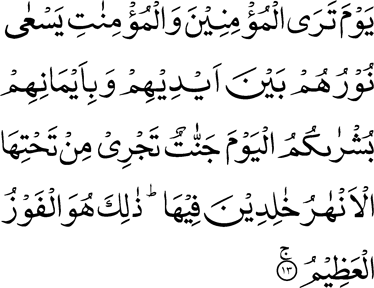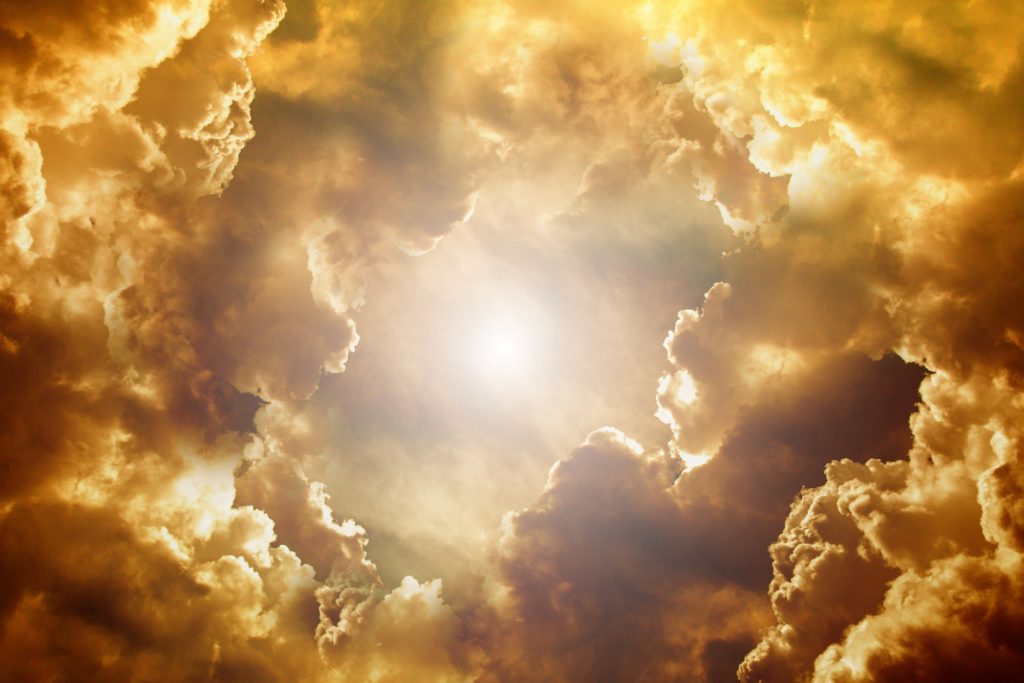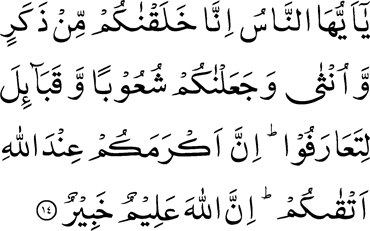Social Media Critic: This is not something unique to Ahmadiyya as such, but I was tagged where an Ahmadi Murabbi is supporting this idea so I thought it relevant to engage with him. Now that the Murabbi himself is unable to make sense of it, I feel it pertinent to make a post about it.
“Nur [Light] in the face” is a sort of religiously transmitted racism. Ironically, it is the way Muhammad Ali [the famous boxer] talked about it, but he argued with reference to Christianity where imagery and art is popular. Islam often gets away with it because their Nur is often verbally expressed, not represented in pictures as often. Going to the root of it, the Quran uses the term Nur to represent guidance, righteousness and ascension in spirituality. Even the Quranic god exemplified himself as Noor/Light in the Quran [Surah Noor, verse 35 to be exact]. On the other hand, darkness is taken as rejection, deception, and decline in spirituality.
In the subcontinental culture, it is used not just with reference to spirituality but also as a sign of beauty when old ladies meet and greet the young bride on her wedding day they often talk about Nur/Light on her face. This typically refers to the bride’s complexion given the social stigma against darker complexions. It is the local form of racism in the subcontinent with a sprinkling of religious blessing.
From Ajay Devgan [bollywood actor] romantically committing racism in his dialogue “Ye Aankhain, Ye Chehra, Ye Noor, Insaan ho ya Pari ho tum” [These eyes, this face, this light/noor, are you a human or a fairy?] to God stating in the Quran:
For them who have done good is the best [reward] and extra. No darkness will cover their faces, nor humiliation. Those are companions of Paradise; they will abide therein eternally [10:26]
Hadeeth is also full of the same this particular tradition in Jam’i Tirmidhi[One of the Sihah Sitta] is particularly interesting, although Sahih Bukhari and Muslim also contain traditions testifying to the same:
Narrated Abu Hurairah:
that regarding the saying of Allah, Most High: “The Day when We shall call together all human beings with their (respective) Imam (17:71)” the Prophet (sa) said: “One of you will be called out to be given his record in his right hand, he will be grown in his body to sixty forearm-lengths, his face will be whitened, and a crown of sparkling pearls will be placed upon his head. So he will go to his companions, who can see him from afar, and they will say: ‘O Allah! Bring this one to us, and let us be blessed by him.’ Until he reaches them, and says to them: ‘Receive the good news! For each man among you shall be the likes of this.’” [He (sa) said:] “As for the disbeliever, then his face shall be blackened, he will be grown in his body to sixty forearm-lengths in the image of Adam, he will given a crown, and his companions will see him and say: ‘We seek refuge in Allah from the evil of this one. O Allah! Do not bring this one to us.’” He said: “So when he reaches them, they say: ‘O Allah! Take him away’ so they will be told: ‘May Allah cast you away! Indeed for each man among you is the likes of this.’”
So when Ahmadi Murabbi Ibrahim Noonan talks about Pure Nur on Mirza Masroor Ahmed’s face, I wonder how that is not alluding to these racist tendencies of Islam and Ahmadiyyat. However, despite clear explanation that spiritual things [if they exist] are not apparent in photos and physical things are not spiritual, Murabbi sahab insists that I do not understand because Abu Jahal could not see Nur on the face of Muhammad. The irony is that Amr ibn Hisham was known as AbulHakam [Father of Wisdom] before Muhammad forced his followers to call him Abu Jahal [father of ignorance].
Response: Before the concept of ‘Nur[light] on the face’ is tackled, it must first be understood that this is in no way a ‘religiously transmitted racism’. You, yourself, have defined Nur “to represent guidance, righteousness and ascension in spirituality” and then go on to misconstruct its meaning to apply to racial terms. From the meaning of Nur which is described within the Qur’an, and the description which you provide, it becomes evident that this ‘light’ is one which is attained as a result of one’s good deeds, rather than it having been racially acquired. Similar to the hadith which was presented, the Qur’an describes this state of spiritual ‘light’ and ‘darkness’ as such:


On the day when some faces shall be white, and some faces shall be black. As for those whose faces will be black, it will be said to them: ‘Did you disbelieve after believing? Taste, then, the punishment because you disbelieved.’
3:107
As to why some souls were made to appear as “white” or “black”, the description found in the 5 Vol. Commentary is as such:
When a person does a deed for which he is praised, the Arabs say of him ابیض وجه فلان i.e. the face of such a one has become white or قد بیض الله وجه فلان i.e. God has made the face of such a one white. On the contrary, if a person does a deed for which he is reproached, it is said of him اسود وجھه i.e. his face has become black, or سود الله وجھه i.e. Allah has blackened his face. Thus, the words یوم تبیض وجوہ و تسود وجوہ (lit. when some faces shall turn white and some faces shall turn black) mean, when some will be praised for their deeds, and some will be reproached; or they mean, when some will rejoice and some will grieve.
English w/ 5 Vol. Commentary (2018), 541-452
It becomes evident that the distinction in brightness, which would become apparent with regards to the souls on the day of judgment, is conditional with regards to the deeds that they have performed on earth. This meaning is also corroborated with another verse of the Holy Qur’an:

And think of the day when thou wilt see the believing men and the believing women, their light running before them and on their right hands, and it will be said to them, ‘Glad tidings for you this day! Gardens through which streams flow, wherein you will abide. That is the supreme triumph.’
57:13
Within this verse ‘light’ is also described to be subjective to one’s deeds:
The words, “their light,” mean the light of their faith and good actions which on the “day of distress and darkness”, (i.e. for disbelievers) will lead believers to their goal. Thus their faith and good works will assume the form of light on the ‘Day of Resurrection.’ “Light” may also mean the light of Divine realization and the capacity to seek and achieve the pleasure of God in this very life.
English w/ 5 Vol. Commentary (2018), 3096

To say that Islam and Ahmadiyyat have ‘racial tendencies’ is something which I find to be unjustly misconstructed. The teachings of Islam remain grounded on the idea that superiority among diversity can only be attained through one’s righteousness and good deeds, rather than having it bestowed, per-conditionally, upon a certain type of people. This is supported by the Qur’an and Hadith:

O mankind, We have created you from a male and a female; and We have made you into tribes and sub-tribes that you may recognize one another. Verily, the most honourable among you, in the sight of Allah, is he who is the most righteous among you. Surely, Allah is All-knowing, All-Aware.
49:14
يا أيها الناس ألا إن ربكم واحد وإن أباكم واحد ـ ألا لا فضل لعربي على أعجمي ولا لعجمي على عربي ولا لأحمر على أسود ولا أسود على أحمر إلا بالتقوى ـ أبلغت؟
The Holy Prophet Muhammad (sa) said:
“O people, your Lord is one and your father Adam is one. There is no favour of an Arab over a foreigner, nor a foreigner over an Arab, and neither white skin over black skin, nor black skin over white skin, except by righteousness. Have I not delivered the message?”
Musnad Ahmed, Hadith 22978

Now when understanding ‘Nur in the face,’ one must also understand that ‘beauty lies in the eyes of the beholder.’ Beauty, while being a physical trait, varies depending upon the onlooker. To some, certain traits and attributes may seem more attractive than others. Keeping this view, the level of love which people share for the Khalifa must be remembered. This love is formed after having witnessed his various qualities which have captivated their hearts. When they set their gaze to the Khalifa, they see the purity of his action, his relationship and status with God, the divine support he receives with regards to his tasks, the acceptance of his prayers, the essence of his guidance, his compassion to mankind, his diligence and commitment to his work, the level of guidance one has received through him and so on. Thus the spiritual light that they witness from the face of Huzoor is one that compliments his purity and righteousness. To an onlooker who has not yet witnessed Huzoor or holds varying opinions with regards to him, his spiritual essence may not be as visible to him. In regards to the onlookers, they are not subjective only to Ahmadis, rather many non-Ahmadis have also testified to seeing spiritual light emanate from Huzoor shortly after meeting with him.
Professor Craig Considine after meeting with Hadhrat Khalifatul Masih V (may Allah be his Helper) has stated:
“Genuinely, that was one of the most special meetings in my entire life. The whole room felt like it was covered in a beautiful pure light. To be in the presence of the Khalifa was a surreal moment in my life. It became a room of love and compassion and the peaceful demeanor and thirst for knowledge were the two things that I felt most strongly from His Holiness. His spirit emanated light, peace and most of all love. Honestly, it felt like he had a ‘halo’ around him from which stemmed warmth and pure goodness. Meeting the Khalifa was like being in the presence of your most beloved grandfather, who loves you and has unmatched wisdom. Now the meeting has ended I wish I could meet him again.”
Huzoor’s Tour of the United States and Guatemala, October-November 2018, A Personal Account by Abid Khan, p. 23
Following the Masroor Mosque Reception, a Muslim guest, Robert Salam had described Huzoor’s personality as such:
“The disposition and character of the Khalifa had a big effect on me. He is extremely friendly and I cannot articulate in words how I felt when I saw him. He is humble and soft and I feel he also has a sense of humour. He radiates an inner light and peacefulness that is just overwhelming.”
Huzoor’s Tour of the United States and Guatemala, October-November 2018, A Personal Account by Abid Khan, p. 40
A devout Catholic, Mr. Strang, after meeting Hadhrat Khalifatul Masih V (may Allah be his Helper) stated:
“When you see the Khalifa you automatically respect him. A spiritual light seems to accompany him. I am a devout Catholic but the feelings of respect I felt for the Khalifa were equal to the respect I have for the Pope. I will most certainly tell all other people how the Khalifa spoke only of peace and tolerance.”
HUZOOR’S TOUR OF GERMANY, MAY-JUNE 2015, A PERSONAL ACCOUNT (PART 3) BY ABID KHAN, P. 74
When people meet the Khalifa, especially those who have a pure heart, they witness his sincerity and his compassion towards people. His attributes and qualities bring a form of majesty to those who then view him, and thus they perceive a spiritual glow emanating from his countenance.
It must also be noted that it is not uncommon for one to view certain personal traits reflected on the face of a person. In fact, a growing number of studies have linked facial images to personality. It has been established that, through some degree of accuracy, humans can perceive certain traits from each other’s faces (https://www.nature.com/articles/s41598-020-65358-6#Abs1).
When it comes to God’s vicegerent on earth, their facial features tend to compliment their piety, sincerity and righteousness. It is for this reason that many people can perceive their spiritual eminence simply by witnessing them. An account of this can be found from Jewish Rabbi, Al-Husayn ibn Salam (later changed his name to Abdullah bin Salam following his conversion to Islam) when he first witnessed the Holy Prophet (sa):
قَالَ لَمَّا قَدِمَ النَّبِيُّ ـ صلى الله عليه وسلم ـ الْمَدِينَةَ انْجَفَلَ النَّاسُ قِبَلَهُ وَقِيلَ قَدْ قَدِمَ رَسُولُ اللَّهِ ـ صلى الله عليه وسلم ـ قَدْ قَدِمَ رَسُولُ اللَّهِ قَدْ قَدِمَ رَسُولُ اللَّهِ . ثَلاَثًا فَجِئْتُ فِي النَّاسِ لأَنْظُرَ فَلَمَّا تَبَيَّنْتُ وَجْهَهُ عَرَفْتُ أَنَّ وَجْهَهُ لَيْسَ بِوَجْهِ كَذَّابٍ فَكَانَ أَوَّلَ شَىْءٍ سَمِعْتُهُ تَكَلَّمَ بِهِ أَنْ قَالَ “ يَا أَيُّهَا النَّاسُ أَفْشُوا السَّلاَمَ وَأَطْعِمُوا الطَّعَامَ وَصِلُوا الأَرْحَامَ وَصَلُّوا بِاللَّيْلِ وَالنَّاسُ نِيَامٌ تَدْخُلُوا الْجَنَّةَ بِسَلاَمٍ ”
When the Prophet (sa) came to Al-Madinah, the people rushed to meet him, and it was said: ‘The Messenger of Allah (sa) has come! The Messenger of Allah (sa) has come! The Messenger of Allah (sa) has come!’ three times. I came with the people to see him, and when I saw his face clearly, I knew that his face was not the face of a liar. The first thing I heard him say was when he said: ‘O people! Spread (the greeting of) Salam [peace], feed others, uphold the ties of kinship, and pray during the night when people are sleeping, and you will enter Paradise with Salam [Peace].
Sunan Ibn Majah, 3251
This Rabbi upon witnessing the complexion of the Holy Prophet (sa) had perceived his trait of truthfulness and thus could not come to grips with the descriptions of his enemies claiming him to be a liar. This phenomenon has also been experienced by the Promised Messiah (as):
Those people, on account of the distance of thousands of miles, cannot come to me nor can they look at my face. Therefore the sagacious of that land reflect upon my inner condition by looking at my picture. There are many who have written letters to me from Europe and America and in their letters they have written that they had looked at my picture carefully and on the basis of the art of face reading they were forced to admit that it was not the picture of a liar. One American woman, upon seeing my picture, said that it was the picture of Yasu‘ [Jesus]; that is, ‘Isa, may peace be upon him.
Barahin-e-Ahmadiyya, vol. 5, p. 490
Thus, it is experienced with believers and non-believers alike that those who witness God’s messengers, with pure intent, can perceive qualities of their virtuousness. The perception of these qualities coupled with their personal experiences testifies for them the character of these men of God. It is at this point where one recognizes the beauty of their character and thus notices Nur (spiritual light) from their countenance. It is for this reason that countless Ahmadis and non-Ahmadis perceive this spiritual light from the face of Huzoor. They have witnessed and testified to these majestic qualities of Huzoor and have become those beholders who find beauty in his character, and by gazing upon his spiritual essence they find a form of light attached to it.
An additional point to mention is that Nur is also used to describe the glow one receives by performing good deeds, as described in the commentary of verse 107 of Surah Al-e-Imran which has been presented above. When one performs a deed or receives news by which an emotional response is triggered, the body expression of that emotion tends to display a form of light or darkness. For example, in the case of one who has performed a misdeed, of which he becomes cognizant of and realizes the error of his actions, they would be struck by a form of grief that would become visible upon their faces. Such despair is bound to cover the complexion of that person with a form of darkness that can be perceived through certain changes within the elements of their image. This very nature is described with the Qur’an as such:

Yet when tidings are given to one of them of that the like of which he ascribes to the Gracious God, his face becomes darkened and he is choked with grief.
43:18
Likewise, similar changes within one’s complexion also take place with the reception of unwelcoming news, as the Qur’an describes the reaction of ancient Arabs to the news of a female-birth :

And when to one of them is conveyed the tidings of the birth of a female, his face darkens, while he suppresses his inward grief.
16:59
The fact that performance of good deeds leads to emotions of contentment and job becoming apparent on the face has been discussed by Hazrat Khalifatul Masih (may Allah be his Helper) in relation to the Promised Messiah (as) as follows:
Dr. Abdul Majeed Khan sahib related that once during the heat of summer he followed the Promised Messiah (on whom be peace) as he went outside, who told him not to follow him and went to sit under the shade of a small tree. After a short while, the Promised Messiah (on whom be peace) returned for Zuhr Salat and his face glowed. Huzur said certainly he must have received some glad-tiding from God.
Friday Sermon, January 29, 2010
Now regarding Huzoor, whose actions are widely known by Ahmadis, and as a vicegerent of God on earth who continues to receive glad tidings from his Lord, it would not be uncanny for one to say that they see light or glow from Huzoor’s face. It is due to the calm and jubilant emotions of Huzoor that causes one to discern a type of glow from his aura.
Concerning the example of Abu Jahl as one who was unable to see Nur on the countenance of the Holy Prophet (sa), he exemplifies those onlookers who do not perceive the same beauty of an element as do others. We do not claim that there is physical light radiating from the faces of God’s messengers or caliphs. If this was the case, enemies of Islam like Abu Jahl would have no reason to reject the Holy Prophet (sa). Rather, this light is one that is perceived after an understanding of majestic and beautiful qualities that the individual possesses from which an observer is then able to perceive beauty and Nur emanating from their countenance. Now when one remains unaware of their qualities or, like in the case of Abu Jahl, possesses a feeling of enmity, animosity and hatred against the individual, then their perception of them would not take the same form and thus would be unable to witness Nur from their face. Abu Jahl had lived a life of antagonism towards the Holy Prophet (sa), so it would only be natural for him not to witness any spiritual light from his personage.
You go on to claim that ‘Muhammad forced his followers to call him Abu Jahal [father of ignorance]’. Let it be clear that the Holy Prophet (saw) had in no way compelled any of his followers to call Amr ibn Hisham Abu Jahl. He was a man who acted upon the teaching of the Holy Quran that there is no compulsion in religion (2:257).
You will not find in any narration that Prophet Muhammad (sa) ordered his followers to label Amir ibn Hisham as Abu Jahl. The Holy Prophet (sa) gave Amir ibn Hisham this title due to his ferocious, unjust and inhumane treatment of the Muslims. These Muslims then adopted this name for him as well, as they were among those who were harassed, tortured and brutally beaten by him, or among those who witnessed these atrocious acts. Examples of these cases of persecution are listed below:
Zunairah (ra) was a concubine of the Banu Makhzum. Abu Jahl beat her so mercilessly that she lost her sight. Abu Jahl would point to her and tauntingly say, “If Islam was true, would it be that she received it, while we were left deprived?”
The Life & Character of the Seal of Prophets (sa) – Volume I, p. 196
As for the elderly Sumaiyyahra, the cruel Abū Jahl struck a spear into her thigh so mercilessly that piercing her body it reached her private area, and this innocent lady gave her life tossing in pain at that very place.
The Life & Character of the Seal of Prophets (sa) – Volume I, p. 197
Then, at another instance, the Holy Prophet(sa) was in prostration before God the Almighty in the courtyard of the Ka‘bah, where a few Chieftains of the Quraish were gathered as well. Abu Jahl said, “At this time, if someone can muster the courage, throw the uterus of a camel upon Muhammad [sa]” Hence, ‘Uqbah bin Abi Mu‘it stood up and threw the uterus of a slaughtered camel, full of blood and filth, upon the back of the Holy Prophet (sa), and all of them burst into laughter.
Sahih Bukhari, Kitabul-Maghazi, Babu Du‘a’in-Nabiyyi (sa) ‘ala Kuffari Quraish……, Hadith No. 3960
[A companion narrates that:] At one instance, when I had not yet become Muslim, Abu Jahl was behind the Holy Prophet (sa) and would throw filth upon the Holy Prophet (sa) saying, “O People! Do not be lured into his trickery. He wishes to turn you from the worship of Lat and ‘Uzza”
Musnad Imam Ahmad bin Hanbal, Volume 5, p. 680, Hadithu Shaikhim-min Bani Malik bin Kinanah, Hadith No. 16720, Beirut (1998)
The moment Amir ibn Hisham began his fierce opposition against the minority Muslim group in Arabia, his actions were never indicative of a man of wisdom, rather they resembled those of a ruthless tyrant. It is for this reason that the title of Abu Al-Hakam was most unbefitting to his new profound animosity. His actions had instead earned him the title of Abu Jahl.
Further Reading:
https://www.alislam.org/book/islam-human-rights/